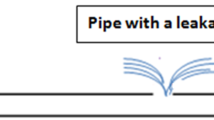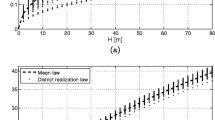Abstract
The relationships between leak geometry and detectability are explored with a distinction between steady- and unsteady-state based techniques. Various criteria to evaluate the size and detectability of a leak are first discussed. These criteria can be useful for the benchmarking and the comparison of different techniques. Since the test conditions play a crucial rule in leak detectability, the proposed criteria take this effect into account. Furthermore, they show that while in steady-state conditions increases in system pressure enhance leak detectability, in transient state, by contrast, higher pressures tend to decrease detectability. This effect is also confirmed by experimental tests carried out at the Water Engineering Laboratory of the University of Perugia.











Similar content being viewed by others
References
Araujo LS, Ramos H, Coelho ST (2006) Pressure control for leakage minimisation in water distribution systems management. Water Resour Manag 20(1):133–149
Brunone B (1989) A technique for leak detection in wastewater outfalls. Numerical experiments (in italian). In: Proceedings Conference on Wastewater Outfalls, Naples, pp D/223–D/236
Brunone B (1999) A transient test-based technique for leak detection in outfall pipes. J Water Resour Plan Manag ASCE 125(5):302–306
Brunone B, Ferrante M (2001) Detecting leaks in pressurised pipes by means of transients. J Hydraul Res IAHR 39(5):539–547
Brunone B, Ferrante M (2004) Closure of Detecting leaks in pressurised pipes by means of transients, by Brunone B and Ferrante M. J Hydraul Res IAHR 42(1):105–109
Brunone B, Ferrante M, Meniconi S (2008) Portable pressure wave-maker for leak detection and pipe system characterization. J Am Water Works Assoc 100(4):108–116
Colombo A, Karney B (2002) Energy and costs of leaky pipes: toward a comprehensive picture. J Water Resour Plan Manag ASCE 128(6):441–450
Colombo AF, Lee P, Karney BW (2009) A selective literature review of transient-based leak detection methods. J Hydro Environ Res 2(4):212–227
Covas D, Ramos H (2010) Case studies of leak detection and location in water pipe systems by inverse transient analysis. J Water Resour Plan Manag ASCE 136(2):248–257
Duan H-F, Lee P, Ghidaoui M, Tung Y-K (2010) Essential system response information for transient-based leak detection methods. J Hydraul Res IAHR 48(5):650–657
Duan H-F, Lee P, Ghidaoui M, Tung Y-K (2011) Leak detection in complex series pipelines by using the system freqency response method. J Hydraul Res IAHR 49(2):213–221
Ferrante M (2012) Experimental investigation of the effects of pipe material on the leak head-discharge relationship. J Hydraul Eng ASCE 138(8):736–743
Ferrante M, Brunone B (2003a) Pipe system diagnosis and leak detection by unsteady-state tests. 1. Harmonic analysis. Adv Water Resour 26(1):95–105
Ferrante M, Brunone B (2003b) Pipe system diagnosis and leak detection by unsteady-state tests. 2. Wavelet analysis. Adv Water Resour 26(1):107–116
Ferrante M, Brunone B, Meniconi S (2007) Wavelets for the analysis of transient pressure signals for leak detection. J Hydraul Eng ASCE 133(11):1274–1282
Ferrante M, Brunone B, Meniconi S (2009a) Leak detection in branched pipe systems coupling wavelet analysis and a Lagrangian model. J Water Supply Res Technol AQUA 58(2):95–106
Ferrante M, Brunone B, Meniconi S (2009b) Leak-edge detection. J Hydraul Res IAHR 47(2):233–241
Ferrante M, Massari C, Brunone B, Meniconi S (2011) Experimental evidence of hysteresis in the head-discharge relationship for a leak in a polyethylene pipe. J Hydraul Eng ASCE 137:775–780
Ghazali M, Beck S, Shucksmith J, Boxall J, Staszewski W (2012) Frequency domain analysis for detecting pipeline leaks. Mech Syst Signal Process 29:187–200
Gong J, Lambert MF, Simpson AR, Zecchin AC (2013) Single-event leak detection in pipeline using first three resonant responses. J Hydraul Eng ASCE 139(6):645–655
Greyvenstein B, van Zyl JE (2007) An experimental investigation into the pressure - leakage relationship of some failed water pipes. J Water Supply Res Technol AQUA 56(2):117–124
Jonsson L (1994) Leak detection in pipelines using hydraulic transients. In: Proceedings 5th Int Conf on Hydraulic Engineering Software, pp 343–352
Jonsson L (1999) Hydraulic transients as a monitoring device. In: Proceedings XXVIII IAHR Congress, CD ROM
Jonsson L (2001) Interaction of a hydraulic transient with a leak in a pipe flow. In: Proceedings 14th Australasian Fluid Mechanics Conference, pp 909–912
Jonsson L, Larson M (1992) Leak detection through hydraulic transient analysis. In: Proceedings International Conference on Pipeline Systems, pp 273–286
Kapelan Z, Savic D, Walters G (2003) A hybrid inverse transient model for leakage detection and roughness calibration in pipe networks. Urban Water J 41(5):481–492
Kapelan Z, Savic D, Walters G (2004) Incorporation of prior information on parameters in inverse transient analysis for leak detection and roughness calibration. Urban Water J 1(2):129–143
Kim S (2005) Extensive development of leak detection algorithm by impulse response method. J Hydraul Eng ASCE 131(3):201–208
Lambert A, Hirner W (2000) Losses from water supply systems: standard terminology and recommended performances measures. the blue pages IWA, (10), pp 1–13
Lee P, Lambert M, Simpson A, Vitkovsky J, Liggett J (2006) Experimental verification of the frequency response method for pipeline leak detection. J Hydraul Res IAHR 44(5):693–707
Lee P, Lambert M, Simpson A, Vitkovsky J, Misiunas D (2007a) Leak location in single pipelines using transient reflections. Aust J Water Res 11(1):53–65
Lee P, Vitkovsky J, Lambert M, Simpson A, Liggett J (2005) Frequency domain analysis for detecting pipeline leaks. J Hydraul Eng ASCE 131(7):596–604
Lee P, Vitkovsky J, Lambert M, Simpson A, Liggett J (2007b) Leak location in pipelines using the impulse response function. J Hydraul Res IAHR 45(5):643–652
Liggett J, Chen L (1994) Inverse transient analysis in pipe networks. J Hydraul Eng ASCE 120(8):934–955
Liou C (1998) Pipeline leak detection by impulse response extraction. J Hydraul Eng ASME 120:833–838
Liou J, Tian J (1995) Leak detection - transient flow simulation approaches. J Energ Resour 117:243–248
Massari C, Ferrante M, Brunone B, Meniconi S (2012) Is the leak head–discharge relationship in polyethylene pipes a bijective function? J Hydraul Res IAHR 50(4):409–417
Massari C, Yeh T-C J, Brunone B, Ferrante M (2013) Diagnosis of pipe systems by means of a stochastic successive linear estimator. Water Resour Manag 27(13):4637–4654
Meniconi S, Brunone B, Ferrante M (2012a) Water-hammer pressure waves interaction at cross-section changes in series in viscoelastic pipes. J Fluid Struct 33:44–58
Meniconi S, Brunone B, Ferrante M, Massari C (2012b) Transient hydrodynamics of in-line valves in viscoelastic pressurized pipes: long-period analysis. Exp Fluids 53(1):265–275
Meniconi S, Brunone B, Ferrante M, Massari C (2013) Numerical and experimental investigation of leaks in viscoelastic pressurized pipe flow. DWES 6(1):11–16
Mpesha W, Chaudhry M, Gassman S (2002) Leak detection in pipes by frequency response method using a step excitation. J Hydraul Res IAHR 40(1):55–62
Mpesha W, Gassman S, Chaudhry M (2001) Leak detection in pipes by frequency response method. J Hydraul Eng ASCE 127(2):134–147
Pudar R, Liggett J (1992) Leaks in pipe networks. J Hydraul Eng ASCE 118(7):1031–1046
Puust R, Kapelan Z, Savic D, Koppel T (2010) A review of methods for leakage management in pipe networks. Urban Water J 7(1):25–45
Shamloo H, Haghighi A (2009) Leak detection in pipelines by inverse backward transient analysis. J Hydraul Res IAHR 47(3):311–318
Silva R, Buiatti C, Cruz S, Pereira J (1996) Pressure wave behaviour and leak detection in pipelines. Comput Chem Eng 20:S491–S496
Soares AK, Covas DIC, Reis LFR (2011) Leak detection by inverse transient analysis in an experimental PVC pipe system. J Hydroinformatics 13 (2):153
Stoianov I, Karney B, Covas D, Maksimovic C, Graham N (2001) Wavelet processing of transient signals for pipeline leak location and quantification. In: Proceedings International Conference on Computing and Control for the Water Industry (CCWI), pp 65–76
Vitkovsky J, Lambert M, Simpson A, Liggett J (2007) Experimental observation and analysis of inverse transients for pipeline leak detection. J Water Resour Plan Manag ASCE 136(6):519–530
Vítkovský J, Simpson AR, Lambert M (2000) Leak detection and calibration using transients and genetic algorithms. J Water Resour Plan Manag ASCE 126(4):262–265
Walski T, Bezts W, Posluszny E, Weir M (2006) Modeling leakage reduction through pressure control. J Am Water Works Assoc 98(4):147–155
Wang X-J, Lambert M, Simpson A, Liggett J, Vitkovsky J (2002) Leak detection in pipelines using the damping of fluid transients. J Hydraul Eng ASCE 128(7):697–711
Acknowledgments
This research has been supported by the Italian Ministry of Education, University and Research (MIUR), under the Projects of Relevant National Interest “Advanced analysis tools for the management of water losses in urban aqueducts”, “Tools and procedures for an advanced and sustainable management of water distribution systems”, and Fondazione Cassa Risparmio Perugia under the project “Hydraulic characterization of innovative pipe materials” (no. 2013.0050.021).
Author information
Authors and Affiliations
Corresponding author
Rights and permissions
About this article
Cite this article
Ferrante, M., Brunone, B., Meniconi, S. et al. Leak Size, Detectability and Test Conditions in Pressurized Pipe Systems. Water Resour Manage 28, 4583–4598 (2014). https://doi.org/10.1007/s11269-014-0752-6
Received:
Accepted:
Published:
Issue Date:
DOI: https://doi.org/10.1007/s11269-014-0752-6




